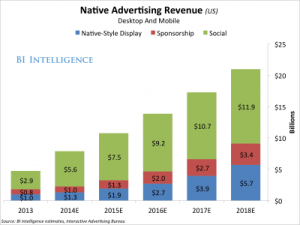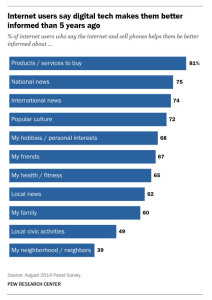Native-style display ads, ad viewability, how users access news and learn online, growth in newspapers’ digital audiences, and more are among the topics covered in this month’s installment of TFP’s Media Metrics roundup.
To help you keep up with trends and prepare for changes just around the corner, each month we compile excerpts from some key reports covering issues affecting the publishing and media industries. Here are our top picks.
Native Is Reviving The Display Ad — Here’s Why Publishers And Marketers Are So Bullish (Business Insider)
- A BI Intelligence report projected that native ad spend will hit $7.9 billion in 2014 and jump to $21 billion in 2018.
- Of the three native ad types — social-native ads, native-style display ads, and sponsored content — social native will bring in the most revenue between 2013 and 2018, while the native-style display category will grow the fastest.
- The study also noted that native-style ads perform better than traditional display, especially on mobile, highlighting data from Polar Media Group and Celtra that shows average click-through rates (CTRs) of 0.15% for desktop native and 1% for native-mobile.
More Than 56% Of Ad Impressions Are Not Seen, Google Says (Search Marketing Daily)
- Google found that more than 56% of all impressions were not viewed in a study of its display advertising platforms, and the average publisher’s rate was only 50.2%.
- It also found that the median viewability rate for above-the-fold ads was 68%, while for those below the fold, the rate was 40%.
- Viewability increased with more captive engagement: Reference sites rated highest, at 51.9%, followed by online communications at 48.9% and games at 48.4%.
- About 12% of publisher sites have viewability rates of 30% or less in Google’s and DoubleClick’s display network.
News From Far Away Fares Better on the Internet (SocialTimes)
- Although much discussion has focused on information overload in the Internet age, a Pew Research Center study found that 72% of respondents reported that they benefit from having this vast source of information, and only 26% said they are overwhelmed by it.
- Respondents viewed the Internet as most useful for getting information about products and services (81%) and accessing national (75%) and international news (74%). Accessing local information rated low, however.
- The study also found that 87% of those surveyed said the Internet and smartphones have helped them learn new things, and 72% of respondents said new technologies have helped them share their ideas and creations.
Newspapers See New Peak in Digital Audience (Capital New York)
- ComScore data compiled by the Newspaper Association of America (NAA) shows that the number of adults accessing U.S. newspapers on digital platforms increased 17% over the past year.
- In the first 10 months of the year, there was an increase of 20 million unique visitors, with 166 million adults now consuming newspaper content digitally.
- The NAA attributed the increase to growth in female and mobile users, noting that the number of mobile users was up 85% year over year in October.
The Global Tablet Market Is Slowing Down, Says IDC (Gigaom)
- According to a report from IDC, the worldwide tablet market will grow just 7.2% this year, a big decline compared with 52.5% growth in 2013.
- Android remains the leading tablet OS, with 68% of the market, which is 16% higher compared with last year.
- iOS, however, will see year-over-year growth decline 12.7%, although Apple still commands 27.5% of the tablet market and will ship 64.9 million units this year.
- The study also found that hybrids, many of which run Windows 8, remain a small category, with just 4% of the combined tablet and hybrid markets.
Programmatic Ad Spending Is Exploding, Driven By Major Investments In Video And Mobile (Business Insider)
- A BI Intelligence report said real-time bidding (RTB) ad spending will reach more than $18.2 billion (33% of U.S. digital ad sales) in 2018. That figure is up from $3.1 billion last year and reflects a 42% growth rate. Programmatic will be 50% of digital ad sales.
- It said mobile and video ads will be a driving force, with RTB spending for those formats reaching $6.8 billion and $3.9 billion by 2018, respectively.
Travelers Share on Facebook and Twitter, Engage on Pinterest (SocialTimes)
- A study from ShareThis found that people predominantly share information about travel related topics on Facebook and Twitter, but they are more likely to engage on that topic via Pinterest, blogging sites, and email.
- It said desktop remains the preferred way to research travel, but smartphones are used more for sharing about travel.
- Some 35% of travel-related content shared on social media comes from millennials, and 71% of those who share about travel are women.
- The study also found that content related to the topic generates 40% more click-backs than other types of content.
Americans Relatively Sanguine About Online Privacy, Study Says (The New York Times)
- A recent survey showed that 62% of respondents in the U.S. are concerned about their online privacy in the wake of Edward Snowden’s revelations about government surveillance, compared with 85% of those in other countries, including Brazil, India, and Nigeria.
- However, only 45% of respondents in the U.S. reported that they believe that the government does “a very good job of making sure the Internet in their country is safe and secure,” and only 31% said that their “private information on the Internet is very secure.”
- Some 76% of Americans said they worry about hackers getting into their bank accounts, and 70% are concerned that their personal messages and photos can be accessed or stolen.
- However, since coverage about Snowden’s revelations began, only 36% of Americans have taken steps to increase their online privacy and security. In contrast, 69% of respondents in India have done so.
Nielsen: Streaming video is way up (Media Life Magazine)
- According to Nielsen, live TV viewership decreased 4% in Q3 compared with the same period last year. That decline included a 3% drop among 18- to 49-year-old viewers.
- TV viewing hours fell from 147 hours and 1 minute per month in 2013 to 141 hours and 19 minutes this year.
- In contrast, video viewing via the Internet climbed from 6 hours and 41 minutes to 10 hours and 42 minutes, a 63% increase.
- The report also said viewing via smartphone jumped from 1 hour and 25 minutes to 1 hour and 46 minutes, an increase of 17%.
Yet More Evidence That Advertisers Are Pulling Money Out Of TV (Business Insider)
- Another report, from the the Standard Media Index, shows a 9% decline in television ad spend in October, “a considerable drop” compared with the same period last year.
- The drop in TV advertising in the first month of Q4 negatively affected the U.S. advertising market overall, with a 4% decline compared with last year.
- The report added that advertisers aren’t locking in to TV ad decisions early but are instead looking to more flexible media options, which is reflected in the 11% year-over-year growth rate digital ad spending has seen this year.
In 2015, Technology Shifts Accelerate and China Rules, IDC Predicts (The New York Times)
- According to IDC, China will see a booming domestic tech market in 2015, with sales of almost 500 million smartphones. That projection is about three times the expected sales in the U.S. and about one third of global sales, The New York Times reported.
- Of the smartphones sold in China next year, about 85% will be made by domestic manufacturers, including Lenovo, Xiaomi, and Huawei.
- The report also said that there will be more than 680 million Internet users in China next year, which is 2.5 times the number in the U.S.
- China will also see 11% growth in spending on information and communications technology, reaching more than $465 billion in 2015. That expansion will account for 43% of tech market growth worldwide.
Media Metrics is a monthly feature from Technology for Publishing, aimed at keeping you armed with the latest industry data. If you’d like to share something you’ve read, drop us a note. And keep up with the latest industry news coverage by signing up for our This Week in Publishing emails or our monthly Publishing Trends newsletter.
Posted by: Margot Knorr Mancini




